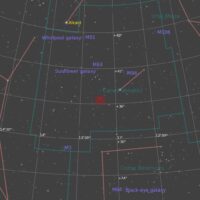NGC 5033
 Click image for full size version
Click image for full size version
August 7, 2022
NGC 5033 is the large spiral galaxy at the centre of this image; NGC 5005 is at lower left. The two form a gravitationally-bound pair around 40 million light years away, but are not yet close enough to distort each other. NGC 5033 has an active galactic nucleus known as a Seyfert nucleus that’s thought to contain a supermassive black hole.
Dozens of other galaxies are highlighted in the annotated image that I prepared. Even more galaxies in the image weren’t in any of the catalogues I searched.
Tekkies:
Acquisition, focusing, and control of Paramount MX mount with N.I.N.A., and TheSkyX. Focus with Optec DirectSync motors and controller. Equipment control with PrimaLuce Labs Eagle 4 Pro computer. All pre-processing and processing in PixInsight. Acquired from my SkyShed in Guelph. Very good transparency and average seeing. Acquired April 28-May 8, 2022 under a mostly moon-free sky.
Sky-Watcher Esprit 150 f/7 refractor and QHY600M camera with Optolong UV/IR filter
95x5m OSC = 7hr55m
The WeightedBatchPreProcessing script was used to perform calibration, cosmetic correction, weighting, registration, local normalization and integration of all frames.
DrizzleIntegration was applied to the OSC frames, and the result was aligned to the Luminance master with StarAlignment. This yielded aligned Lum and Colour masters.
DynamicBackgroundExtraction was applied to the Luminance and OSC masters.
Colour
Colour Calibration: ColorCalibration was used to calibrate the OSC master.
Linear Noise Reduction: NoiseXterminator was used to reduce noise in the background areas with settings Amount=0.9 and Detail=0.15
Stretching: HistogramTransformation was applied to make a pleasing yet bright image.
Luminance
Deconvolution: A star mask was made from the Luminance master to use as a Local Deringing Support Image. The GAME script was used to make a mask selecting only NGC 5033 and 5005 for deconvolution. Deconvolution was applied (50 iterations, regularized Richardson-Lucy, ParametricPSF mode with default settings; Global dark deringing = 0.02; Global bright deringing 0.007).
Linear Noise Reduction: NoiseXterminator was used to reduce noise in the background areas with settings Amount=0.9 and Detail=0.25
Stretching: HistogramTransformation was applied to make a pleasing yet bright image.
Combining Luminance and Colour Images
Luminance addition: LRGBCombination was applied to replace the lightness of the RGB image with the Luminance master.
Additional Processing
Star Removal: StarNet v2 was used to remove stars.
Nonlinear Noise Reduction: NoiseXterminator was used to reduce noise in the background areas of each image with settings Amount=0.9 and Detail=0.25
Contrast Enhancement: LocalHistogramEqualization was applied using an inverted lightness mask to protect the background and select the galaxies. Three passes were applied (scale 20, max contrast 1.5, strength 0.5, 1 iteration; scale 80, max contrast 1.5, strength 0.4, 1 iteration; and scale 150, max contrast 1.5, strength 0.18).
Sharpening: MultiscaleMedianTransform was used with the same mask used for Deconvolution to sharpen Layers 2 – 4 with strengths of 0.05, 0.02 and0.01, respectively.
Star Processing and Restoration: Curves was used to boost saturation in the stars. The stars were added back into the image using straight addition in PixelMath.
Final Steps: Background, galaxy and star brightness, contrast and saturation were adjusted in several iterations using CurvesTransformation with masks as required. MorphologicalTransformation was used in Morphological Selection mode to slightly reduce the size of stars. ICCProfileTransformation (sRGB IEC61966-2.1; Relative Colorimetric with black point compensation) was applied prior to saving as a jpg.








Gorgeous image, like always!